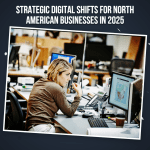AI Moves From Experiment to Essential in Content Creation
By D. Windsor, ievo
The integration of artificial intelligence (AI) into content creation has evolved from a novel exploration into a practical necessity. Across North America, businesses particularly small and medium sized enterprises are leveraging AI not merely as a convenience, but as a critical strategic asset. As competition intensifies and digital engagement becomes a defining metric of success, the demand for high quality, consistent, and multi format content has pushed organizations to reconsider how they build and distribute material across platforms.
AI has emerged as a solution capable of meeting both the speed and sophistication required in modern content delivery. No longer relegated to experimental tools or side projects, AI driven platforms are now deeply embedded in the workflows of marketing, communications, and digital strategy departments across sectors.
The Current Landscape: Why AI Is No Longer Optional
According to recent industry data, the global market for artificial intelligence is projected to exceed $826 billion by 2030. Content generation remains one of the most widely adopted and economically impactful applications of AI, particularly among small and mid market companies.
In practical terms, this means that tools such as ChatGPT, Jasper, Writesonic, and others are now enabling businesses to produce polished written content, develop visual media, and deploy brand consistent messaging in real time. These tools do not just save time they enable scalability. Companies that once struggled to maintain a regular publishing schedule can now engage their audiences with increased frequency and relevance.
Key Benefits: Speed, Consistency, and Reach
- Accelerated Written Output
Businesses no longer need to rely solely on internal writers or external agencies to keep up with content demand. AI tools can generate blogs, emails, ad copy, and social posts in a matter of minutes. This functionality supports marketing teams in managing regular publishing schedules and meeting campaign deadlines without overextension.
In particular, this acceleration enables organizations to be more responsive to market trends, seasonal opportunities, and customer inquiries. Drafting a blog post that once required a week can now be completed in an afternoon, then reviewed and refined by human editors to ensure alignment with brand values and tone. - Reliable Brand Voice Customization
Many AI tools allow for extensive customization of tone, terminology, and brand specific language. Shopify Magic, for example, lets users select from a range of predefined tones while maintaining consistency across all digital touchpoints. This ensures that whether a business is writing product descriptions, email newsletters, or social media posts, the voice remains uniform.
For businesses with multiple product lines, regional audiences, or multilingual requirements, this level of precision reduces miscommunication and enhances brand integrity. - Visual Asset Generation at Scale
AI tools such as Adobe Firefly and Synthesia are redefining the visual production pipeline. Instead of outsourcing video creation or graphic design, businesses can now generate high quality assets from simple text based prompts.
These tools use advanced algorithms to translate ideas into images or videos that are suitable for product showcases, social media, training materials, and more. For resource constrained businesses, this capability bridges the gap between professional output and budget limitations. - Seamless Cross Platform Publishing
Automation is not confined to creation alone. Platforms like StoryChief and Hootsuite enable simultaneous distribution of content across websites, email, and social media, optimizing for each channel’s requirements. AI can also reformat longer pieces into shorter excerpts, increasing their usability across formats such as Reels, blog intros, or LinkedIn updates.
This functionality ensures that the return on content investment is maximized. A single article or campaign asset can serve multiple functions, allowing brands to maintain an omnipresent voice in an increasingly fragmented media environment. - Strategic Analytics and Content Optimization
AI is not only capable of generating content but also of evaluating its performance. Integrated analytics features now assess engagement rates, conversion metrics, and user behavior, offering actionable recommendations for improvement.
This layer of intelligence allows businesses to refine their messaging based on performance, shifting their strategy from reactive to proactive. For instance, if a particular caption style drives more engagement on Instagram, AI tools can replicate that tone for future content ensuring continuous optimization.
Applied Outcomes: AI in the Field
The practical applications of AI in content creation are increasingly evident. A Toronto based bakery, for example, reported a time savings of over ten hours per week after implementing Jasper to automate email campaigns and social media copy. Simultaneously, engagement metrics improved by 35 percent within the first quarter of use.
Similarly, a Canadian logistics firm used Adobe Firefly to create internal training visuals for a multi site rollout. What would have otherwise required coordination with an external agency was completed internally in under two weeks, reducing both time and expense without compromising visual quality.
These cases demonstrate that AI can enhance efficiency and impact, regardless of industry or audience.
Managing the Risks: Human Oversight Remains Essential
While AI offers unmatched speed and capability, human involvement remains vital. Machine generated content must be carefully reviewed to ensure accuracy, appropriateness, and strategic alignment. AI lacks contextual understanding and ethical reasoning, which means it cannot fully replace editorial judgement.
Moreover, companies must be cautious about data usage and compliance. As AI tools collect and process user data to improve personalization, businesses are responsible for adhering to privacy regulations such as GDPR, CCPA, and the Canadian Privacy Act. Transparency, informed consent, and secure data practices are critical components of responsible AI use.
Preparing for What Comes Next
The role of AI in content creation is still expanding. Emerging technologies such as multimodal AI (combining text, image, and video generation) and real time sentiment analysis are on the horizon. Businesses that invest early in understanding and integrating these tools will be better positioned to lead their industries.
It is advisable for decision makers to take the following steps:
- Conduct a comprehensive audit of current content operations.
- Identify areas where AI can reduce friction or accelerate delivery.
- Implement training for staff to effectively use AI tools.
- Establish guidelines for AI oversight and ethical usage.
This structured approach ensures that AI becomes a reliable asset rather than a reactive solution.
Conclusion: Content Creation in the Age of Intelligent Automation
Artificial intelligence has transitioned from a speculative trend to a strategic imperative. For organizations seeking to improve the speed, consistency, and reach of their content operations, AI tools provide a pathway to operational excellence. However, the key lies in implementation that balances automation with oversight, speed with substance, and innovation with integrity.
In a business environment defined by digital presence, AI offers a way forward transforming content creation into a disciplined, data informed, and future ready process. As adoption deepens, the organizations that succeed will be those that treat AI not as a shortcut, but as a cornerstone of their digital strategy.








